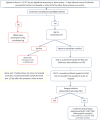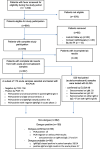Epidemiology and genetic diversity of circulating dengue viruses in Medellin, Colombia: a fever surveillance study
- PMID: 32615988
- PMCID: PMC7331258
- DOI: 10.1186/s12879-020-05172-7
Epidemiology and genetic diversity of circulating dengue viruses in Medellin, Colombia: a fever surveillance study
Abstract
Background: Dengue fever is a major public health problem in Colombia. A fever surveillance study was conducted for evaluation of the clinical, epidemiological, and molecular patterns of dengue, prior to Chikungunya and Zika epidemics.
Methods: In November 2011-February 2014, a passive facility-based surveillance was implemented in Santa Cruz Hospital, Medellin, and enrolled eligible febrile patients between 1 and 65 years-of-age. Acute and convalescent blood samples were collected 10-21 days apart and tested for dengue using IgM/IgG ELISA. RNA was extracted for serotyping using RT-PCR on acute samples and genotyping was performed by sequencing.
Results: Among 537 febrile patients enrolled during the study period, 29% (n = 155) were identified to be dengue-positive. Only 7% of dengue cases were hospitalized, but dengue-positive patients were 2.6 times more likely to be hospitalized, compared to non-dengue cases, based on a logistic regression. From those tested with RT-PCR (n = 173), 17 were dengue-confirmed based on PCR and/or virus isolation showing mostly DENV-3 (n = 9) and DENV-4 (n = 7) with 1 DENV-1. Genotyping results showed that: DENV-1 isolate belongs to the genotype V or American/African genotype; DENV-3 isolates belong to genotype III; and DENV-4 isolates belong to the II genotype and specifically to the IIb sub-genotype or linage.
Conclusions: Our surveillance documented considerable dengue burden in Santa Cruz comuna during non-epidemic years, and genetic diversity of circulating DENV isolates, captured prior to Chikungunya epidemic in 2014 and Zika epidemic in 2015. Our study findings underscore the need for continued surveillance and monitoring of dengue and other arboviruses and serve as epidemiological and molecular evidence base for future studies to assess changes in DENV transmission in Medellin, given emerging and re-emerging arboviral diseases in the region.
Keywords: Colombia; Dengue; Genotyping; Surveillance.
Conflict of interest statement
None. I certify that the authors do not have any relevant financial relationships or potential conflicts of interest to disclose regarding the material discussed in this manuscript.
Figures







Similar articles
-
Epidemiology of dengue fever in Gabon: Results from a health facility-based fever surveillance in Lambaréné and its surroundings.PLoS Negl Trop Dis. 2021 Feb 10;15(2):e0008861. doi: 10.1371/journal.pntd.0008861. eCollection 2021 Feb. PLoS Negl Trop Dis. 2021. PMID: 33566822 Free PMC article.
-
Arbovirus investigation in patients from Mato Grosso during Zika and Chikungunya virus introdution in Brazil, 2015-2016.Acta Trop. 2019 Feb;190:395-402. doi: 10.1016/j.actatropica.2018.12.019. Epub 2018 Dec 12. Acta Trop. 2019. PMID: 30552880
-
Co-circulation and simultaneous co-infection of dengue, chikungunya, and zika viruses in patients with febrile syndrome at the Colombian-Venezuelan border.BMC Infect Dis. 2018 Jan 30;18(1):61. doi: 10.1186/s12879-018-2976-1. BMC Infect Dis. 2018. PMID: 29382300 Free PMC article.
-
The Epidemiological Impact of Dengue in Colombia: A Systematic Review.Am J Trop Med Hyg. 2024 Oct 29;112(1):182-188. doi: 10.4269/ajtmh.23-0907. Print 2025 Jan 8. Am J Trop Med Hyg. 2024. PMID: 39471503 Free PMC article.
-
High Seroprevalence of Dengue Virus Infection in Sudan: Systematic Review and Meta-Analysis.Trop Med Infect Dis. 2020 Jul 18;5(3):120. doi: 10.3390/tropicalmed5030120. Trop Med Infect Dis. 2020. PMID: 32708492 Free PMC article. Review.
Cited by
-
Multifoci and multiserotypes circulation of dengue virus in Senegal between 2017 and 2018.BMC Infect Dis. 2021 Aug 24;21(1):867. doi: 10.1186/s12879-021-06580-z. BMC Infect Dis. 2021. PMID: 34429064 Free PMC article.
-
Spatial and temporal population dynamics of male and female Aedes albopictus at a local scale in Medellín, Colombia.Parasit Vectors. 2021 Jun 8;14(1):312. doi: 10.1186/s13071-021-04806-2. Parasit Vectors. 2021. PMID: 34103091 Free PMC article.
-
Dengue Burden and Factors Influencing Severity in Honduras: A Descriptive and Analytical Study.Rev Soc Bras Med Trop. 2024 Jun 10;57:e004072024. doi: 10.1590/0037-8682-0594-2023. eCollection 2024. Rev Soc Bras Med Trop. 2024. PMID: 38896654 Free PMC article.
-
Laboratory Findings in Patients with Probable Dengue Diagnosis from an Endemic Area in Colombia in 2018.Viruses. 2021 Jul 19;13(7):1401. doi: 10.3390/v13071401. Viruses. 2021. PMID: 34372606 Free PMC article.
-
Dengue virus genomic surveillance in the applying Wolbachia to eliminate dengue trial reveals genotypic efficacy and disruption of focal transmission.Sci Rep. 2024 Nov 14;14(1):28004. doi: 10.1038/s41598-024-78008-y. Sci Rep. 2024. PMID: 39543157 Free PMC article.
References
-
- World Health Organization. Dengue and severe dengue World Health Organization; 2009. Updated 2 March 2020. Available from: https://www.who.int/en/news-room/fact-sheets/detail/dengue-and-severe-de....
-
- World Health Organization: WHO Position Paper on dengue. In. WHO; 2018: 457–476.
MeSH terms
Grants and funding
LinkOut - more resources
Full Text Sources
Medical

